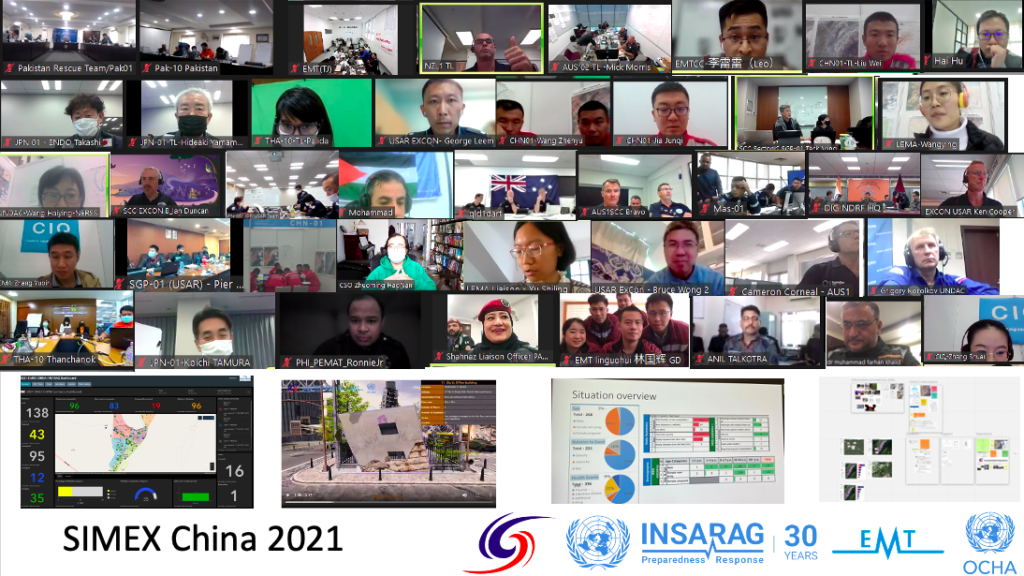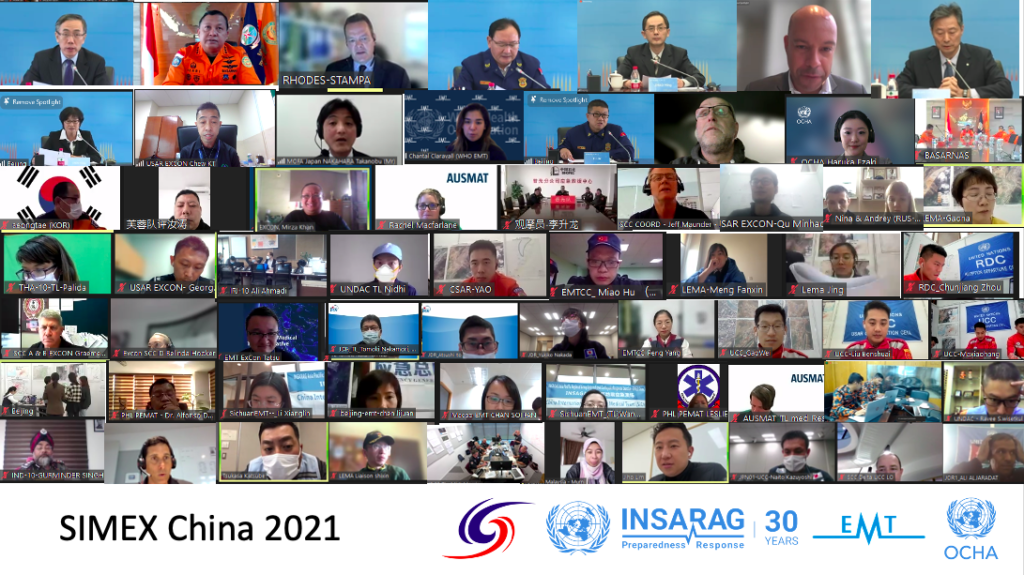Author: Digital Services
Last week the INSARAG Asia-Pacific International Earthquake Response Exercise (IERE) named as “SIMEX China 2021”, hosted by China and strongly supported by the Asia-Pacific Chair Indonesia, Member States, and relevant partners and organizations, took place virtually for 3 days, from the 24 November to 26 November.
The Asia-Pacific Region is one of the most disaster-prone areas in the world. For this reason, this IERE was essential for the regional group to review its response capacities. This online event provided a platform through which participants practiced international coordination of Emergency Medical Teams (EMTs),INSARAG and UNDAC, reflecting the emergency response coordination system of China.
Despite the challenges posed by the COVID-19 pandemic, the “SIMEX China 2021” was a great success with participants from over 30 countries and 4 different international organizations, connecting from all over the world.
After several years of work, involving the entire French USAR community under the coordination of the French General Directorate for Civil Protection and Crisis Management/Office of Doctrine, Training and Equipment, the new national USAR doctrine was published in September 2021. This doctrine is complemented by the national operational and technical guidelines for all French USAR responders: from first responders to regional, national and international teams. As France had committed to, in the context of the INSARAG recognition of its national accreditation process in July 2017, all INSARAG standards have been integrated into these new national guidelines which are now a reference for all USAR operations on the French territory (including overseas) and allowing, if necessary, a perfect coordination with possible international USAR teams requested to assist in France.
These guidelines in French are available following the links below, (it will be translated to English soon):
https://resana.numerique.gouv.fr/public/information/consulterAccessUrl?cle_url=138418266AmgPbwMPVGhXOlQyVzlUdFRqWmcCIwRtVD9VaAZnWmBTZgI3UzhVMFZhBD0=
Sub-WG A Global Position composed of 2 Co-Chair and 16 members, will develop a global INSARAG position on Flexible (Operational) Response, based on the drafted Regional Position Papers on this topic in 2020. The scope of the global position on Flexible Response can also encompass the response beyond collapsed structures and earthquakes, as some regions have already implemented this successfully.
Sub-WG Co Chairs
| Name | Country | Region | Role | Contact |
| Thomas Zeiter | Switzerland | Europe (AEME) | Sub-WG A Co Chair | Thomas.zeiter@eda.admin.ch |
| Otty Rusinarsetyo | Indonesia | Asia-Pacific | Sub-WG A Co Chair | otty.rs@gmail.com |
| Haruka Ezaki | – | Asia-Pacific | INSARAG Secretariat Rep. | haruka.ezaki@un.org |
Meeting Summaries:
Key Documents
Draft ToR – Flexible Response WG, available on this LINK
Annex C: Draft FRWG Timeline
Sub-WG B DACC composed of 2 Co-Chairs and 20 members, will develop the Damage Assessment Coordination Centre (DACC) guidelines and methodology.
Sub-WG Co Chairs
| Name | Country | Region | Role | Contact |
| Solveig Thorvaldsdottir | Iceland | Europe (AEME) | Sub-WG B Co Chair | solveig@rainrace.com |
| Mark Scorer | UK/SARAID | Europe (AEME) | Sub-WG B Co Chair | mark.scorer@saraid.org.uk |
| Ana Maria Rebaza | – | Americas | INSARAG Secretariat Rep. | rebaza@un.org |
Meeting Summaries:
Key Documents
Draft ToR – Flexible Response WG, available on this LINK
Annex C: Draft FRWG Timeline
Sub-WG C Response to Cultural Heritage composed of 2 Co-Chairs and 9 members, will review the draft UNESCO Guidelines on Response to Cultural Heritage and draft an INSARAG Technical Guidance Note on “INSARAG’s Response to Cultural Heritage Sites”.
Sub-WG Co Chairs
| Name | Country | Region | Role | Contact |
| Jing Wang | China | Asia-Pacific | Sub-WG C Co Chair | archsky2008@126.com |
| Aparna Tandon | UNESCO-ICCROM | – | Sub-WG C Co Chair | aparna.tandon1@gmail.com |
| Clement Herbert Kalonga | – | AEME | INSARAG Secretariat Rep. | clement.kalonga@un.org |
2023 Updates:
Urban Search and Rescue at Heritage Sites Version 9.0 – 31 March 2023
2022 Updates:
Presentation by Sub-WG Urban Search & Rescue at Heritage Sites at HNPW 2022 Link
Key Documents:
Draft ToR – Flexible Response WG, available on this LINK.
Annex B: Draft UNESCO Field Guidelines for USAR at Heritage Sites
Annex C: Draft FRWG Timeline
Background Information
In the last few years, humanitarian emergencies have been strongly impacted by climate change. Additionally, due to the challenges imposed by the pandemic, the humanitarian landscape has become even more complex. Therefore, there have been increasing discussions on ways to effectively deploy INSARAG teams in disasters beyond those strictly involving collapsed structures. Those events can often be caused by hydrometeorological and climatological reasons which could make INSARAG teams’ skills extremely relevant, such as specialized capacities for water rescue and flood disaster response.
Given the significant resources and costs associated with the establishment and maintenance of certified USAR teams as well as of their deployments, it is reasonable to explore ways on how to best maximize these professional life-saving resources of USAR teams under the INSARAG’s umbrella, and through global consultations with the three regional groups of INSARAG.
INSARAG has proved to remain flexible and effective despite the challenges of the pandemic and amidst a complex humanitarian environment. The FRWG will aim to contribute to the INSARAG network to continue being relevant and nimble despite the new challenges. The INSARAG network will be strengthened as a result of the review and further development of the Flexible Response concept, the strengthening of teams’ deployments in the BtR phase including the DACC concept and INSARAG’s role in response to affected areas where cultural heritage sites exist.
Composition
The FRWG is composed of three Sub-Working Groups with respective assignments:
- Sub-WG A Global Position with 19 members, will develop a global INSARAG position on Flexible (Operational) Response, based on the drafted Regional Position Papers on this topic in 2020. The scope of the global position on Flexible Response can also encompass the response beyond collapsed structures and earthquakes, as some regions have already implemented this successfully.
- Sub-WG B Disasters Assessment Coordination Center (DACC) with 22, members will develop the Damage Assessment Coordination Centre (DACC) guidelines and methodology.
- Sub-WG C Cultural Heritage with 10 members, will review the draft UNESCO Guidelines on Response to Cultural Heritage and draft an INSARAG Technical Guidance Note on “INSARAG’s Response to Cultural Heritage Sites”.
FRWG OV Co-Chairs and SubWG Co-Chairs
| Name | Country | Region | Role | Contact |
| Paolo Vaccari | Italy | Europe (AEME) | OV Co Chair | paolo.vaccari@protezionecivile.it |
| Paul Baxter | Australia | Asia-Pacific | OV Co Chair | Paul.baxter@fire.nsw.gov.au |
| Thomas Zeiter | Switzerland | Europe (AEME) | Sub-WG A Co Chair | Thomas.zeiter@eda.admin.ch |
| Otty Rusinarsetyo | Indonesia | Asia-Pacific | Sub-WG A Co Chair | otty.rs@gmail.com |
| Solveig Thorvaldsdottir | Iceland | Europe (AEME) | Sub-WG B Co Chair | solveig@rainrace.com |
| Joshua Macabuag | UK/SARAID | Europe (AEME) | Sub-WG B Co Chair | josh.macabuag@saraid.org.uk |
| Jing Wang | China | Asia-Pacific | Sub-WG C Co Chair | archsky2008@126.com |
| Aparna Tandon | UNESCO-ICCROM | – | Sub-WG C Co Chair | aparna.tandon1@gmail.com |
Meeting Summaries:
Chairman Summary of the Meeting with the entire Flexible Response Working Group (FRWG), Friday 17th September, available on this LINK
Key Documents:
Draft ToR – Flexible Response WG, available on this LINK.
Final List of Participants, available on this LINK
Annex A: INSARAG New-Year Teleconference Chairman’s Summary (includes Summary of regional positions on Flexible Response)
Annex B: Draft UNESCO Field Guidelines for USAR at Heritage SitesFor Annex C: Draft FRWG Timeline

 Home
Home  Contact
Contact 
